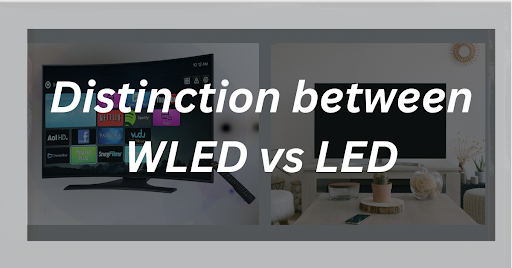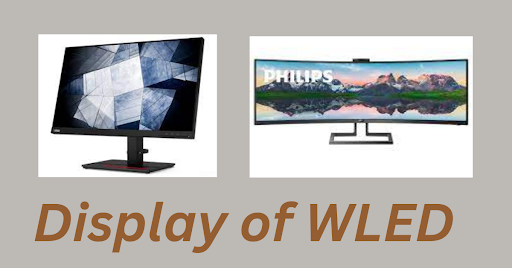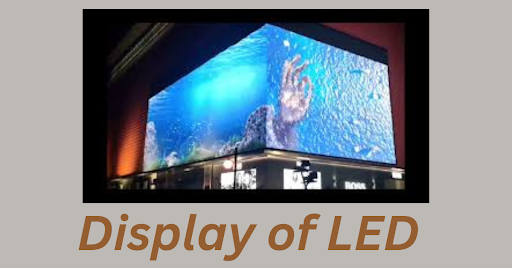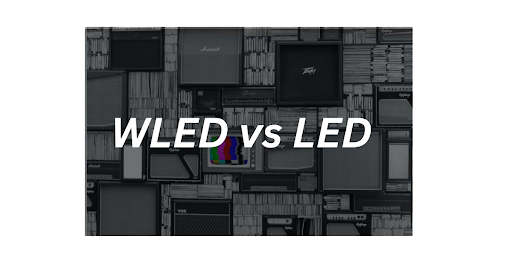WLED is White Light Emitting Diode and LED is Light Emitting Diode. WLED, however, is regarded as a typical LED in all LED displays.
Because businesses employ marketing strategies to get you excited about their products, it is important for you as a buyer to grasp the fundamentals of that particular tech component before making any investment. WLED can therefore be seen as a marketing phrase.
Let’s examine the fundamentals of WLED vs. LED in more detail.
| Feature | WLED | LED |
| Wireless Control | Yes, can be controlled wirelessly | No, requires a wired connection to power |
| Installation | Easier, with minimal wiring and physical connections | Can require more wiring and use of a transformer |
| Brightness and Color | Produce a wide range of colors and brightness levels, create different lighting effects | Produce a single color or a narrow range of colors |
| Energy Efficiency | Both consume less energy than traditional bulbs, but WLEDs have additional energy-saving features | Both consume less energy than traditional bulbs |
| Cost | Generally more expensive than regular LEDs | Generally less expensive than WLEDs |
WLED vs. LED – What is the Difference? [Detailed Guide]
Display of WLED.
A white light-emitting diode is referred to as a WLED. Manufacturers of displays typically use the names WLED and LED interchangeably, and this technology is a typical source of backlighting for digital monitors.
On the other hand, the term LCD is used to describe any LCD monitor or television, including those that make use of WLED illumination.LCD stands for liquid crystal display.
WLED backlighting solutions cost more than CCFL counterparts. Some TV manufacturers refer to all other televisions as LCDs and only employ LED illumination on their most costly models.
WLED backlighting uses a variety of items, including laptop computer displays, flat-screen televisions, and high-definition computer monitors.
Benefits of WLED Display Technology.
WLED backlighting uses less energy than the CCFL standards used for LCD panels, which is an additional significant benefit. Backlighting a display requires a lot of energy, but most of it is filtered away before viewers can see it.
The pixels still block around 95% of the output of the backlight even when the screen is completely white. WLEDs may save even a little amount of energy, which reduces both operating expenses and electricity usage.
WLED panels have additional advantages over LCD displays, which contributes to their higher price. WLED displays begin to display a picture as soon as they have power. LCD displays with CCFL backlights gradually come on and get brighter over time.
WLED monitors provide superior contrast ratios and more brilliant colors in addition to being generally brighter. They can also be slimmer since LEDs take up less room than a CCFL backlight in a conventional LCD.
Wled: Is It Good for Gaming?
A full-array LED display should be your first choice for gaming. Please do not approach the edge lighting. The disadvantage of edge illumination is that there are fewer gaming-friendly viewing angles available. If you want to play video games while seated directly in front of the screen, that won’t be an issue.
However, if you’re going to sit or observe from different angles, you’ll notice that an edge-lit LED becomes less noticeable as you move away from the main viewing position. Edge-lit LEDs, on the other hand, produce more brightness than full-array LEDs, even while you are gaming while standing squarely next to the panel.
Because of the inconsistent lighting (very bright around the edges and darker as you approach the center of the display). Because of the illumination of the pixels, LCDs frequently offer a better viewing experience and are anti-glare compared to edge-lit LEDs.
Display of LED
LEDs are little semiconductors that, when exposed to an electrical current, emit visible light. When compared to traditional lighting, LEDs are frequently more efficient and long-lasting.
The majority of LED monitors and displays feature flat screens, are lightweight, and have a small depth. LEDs provide distinctive design possibilities despite their little size. Few LED bulb combinations genuinely resemble conventional lighting. Some LED lighting systems can include LEDs as a source of durable light.
In addition, there are crossover ways that make use of a current “bulb” or variable light stream design that is specially built for a piece of specified equipment.
Compared to earlier lighting advancements, LEDs offer a major possibility for creating lighting structure components and have a wider variety of uses.
Benefits of LED Display Technology.
The effectiveness, low energy consumption, and thin design of the LED display are its main benefits. Long-term cost-effectiveness and thickness improvements for the LED monitor are anticipated.
- Expanded field of blur
- Genuine excellence
- Higher dynamic discrepancy ratio
- More time to live and less influence on the environment
- Consumes little power
- Petite Sizes
- Alternating Quickly
- Strong in the Body
- Sustained excellence
Are You Confused Between LED and LCD?
In fact, both LED and LCD panels employ liquid crystals to produce pictures. The disparity is caused by the backlights. Although LED displays frequently have greater picture quality, they also come with a range of lighting configurations. And certain illumination configurations result in photos that are better than others. But we have concentrated on LEDs in this article.
Types of Major Led Technology
There are two primary subcategories of LED technology:
IPS (In-Plane Switching) (In-Plane Switching)
VA (Vertical Alignment) (Vertical Alignment)
IPS effectively increases viewing angles, however, it has a poor contrast ratio. VA provides adequate contrast levels but constrained viewing angles at the same time. While there are various other LED varieties available, including:
- Edge LED (LEDs arranged around the edge of the display)
- LED Full-Array (Grid of LEDs behind the LCD)
- RGB LED (Creates a pure white color)
- OLED (Organic Light-Emitting Diodes)
- QLED (Quantum Dot LED)

The Distinction Between Wled Vs Led
If you want the truth, we have to tell you that WLED vs LED is identical in every way. These two are interchangeable. The false statement was propagated on the international market by vendors to their intended customers. Customers choose to acquire items that are more sparkling in today’s vibrant environment. You might think of it as a marketing strategy to increase sales and keep people coming back.
Today, a WLED backlight is present on the majority of LED display displays. Using WLED unquestionably improves vision and guarantees higher visibility and precision. Although there is no distinction between WLED and LED, the titles sometimes deceive consumers. Nevertheless, if the price is a factor, we advise using LEDs. LEDs guarantee superior performance in terms of color, brightness, and power usage. If not, WLED will likewise provide the same outcomes.
Conclusion
We believe the information above makes it apparent that there are no differences between WLED vs LED. Additionally, you now know what WLED is. You may also comprehend the reality for yourself from the definition. Even LED screens employ WLED backlighting. Overall, it’s the sellers’ strategies for boosting their sales and retaining consumers.


